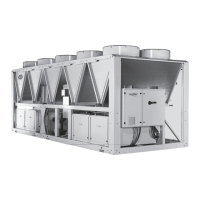26 42GW
Maintenance
The cleaning and maintenance operations must be performed by
qualied personnel.
Before performing any service or maintenance operations, turn OFF
the main power switch.
Note to the installer:
To open the unit grille: turn the two screws through 90° (1/4 turn).
Filter cleaning by the installer
The lter cleaning operations depend on the unit's operating
conditions.
• The filter can be cleaned with water.
Extract the lter.
First vacuum clean the lter, then wash under tap water and nally dry.
Ret the lters correctly.
Prolonged shutdown:
• Before switching the unit back on:
- Clean or replace the unit air filters.
- Check and clean the drain pan and the condensate discharge
of the unit.
- Check tightness of electric connections.
Additional maintenance
• The electric panel is easily accessible
The condensate drain pan must be removed to allow internal
components such as the fan motor assembly, heat exchanger,
condensate drain pump, changeover sensor or electric heater (if
tted) to be inspected or replaced.
Condensate drain pan removal
• Before removing the condensate drain pan, protect the floor by
placing a plastic sheet under the unit to collect any condensation
that may escape.
• Remove the frame-grille assembly by loosening the screws.
• Undo the 4 mounting bolts on the metal cross members and
carefully remove the condensate drain pan.
Draining the installation: If you wish to drain the circuit, please
note that a certain amount of water will remain in the coil. This
water may freeze if the temperature drops below 0°C and cause the
exchanger to rupture.
User guide
Once installation and tests are complete, explain to the user the
main points in the operating and maintenance manual points, paying
particular attention to the unit's main operating modes.
• Switching the unit on and off.
• Changing the operation modes.
• Temperature selection.
Safety considerations relating to nal shut-
down
Separate the units from their energy sources, allow them to cool
down and then drain completely.
Dismantling
Never work on a unit that is still powered on.
Respect the local environmental laws and regulations.
Presence of waste electrical and electronic equipment (WEEE): At
the end of its life, units must be disassembled, with any contaminated
uids removed by professionals, and then processed via approved
channels for waste electrical and electronic equipment (WEEE).
Check whether any part of the unit can be recycled for another
purpose.
Sort the components according to their material for recycling or
disposal, in accordance with regulations in force.
Materials to be recovered for recycling - Steel - Copper - Brass -
Aluminium - Plastics - Insulation.
The proportions of materials for each unit are listed in the Product
Environmental Prole (PEP) available at the following website:
http://www.pep-ecopassport.org/fr/consulter-les-pep/ or on request
from our departments.
Any contaminated uids must be disposed of by specialist
professionals.
Maintenance and user guide

